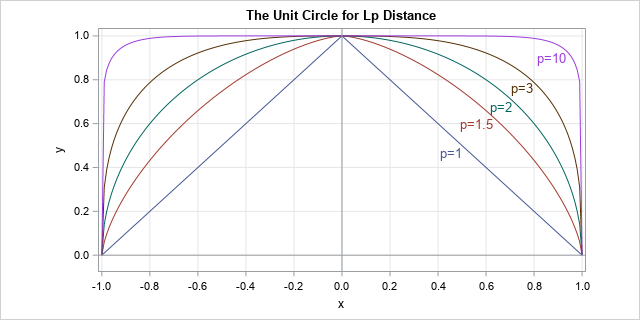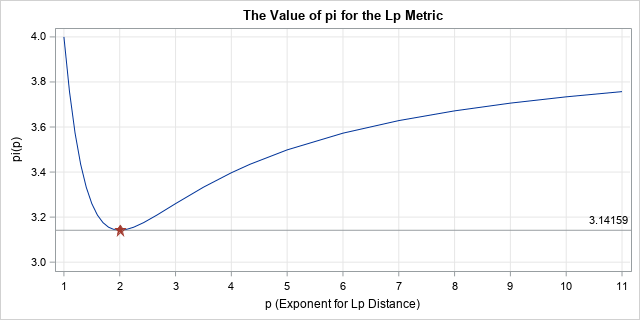It's time to celebrate Pi Day! Every year on March 14th (written 3/14 in the US), math-loving folks celebrate "all things pi-related" because 3.14 is the three-decimal approximation to the mathematical constant, π. Although children learn that pi is approximately 3.14159..., the actual definition of π is the ratio of a circle's circumference to its diameter. Equivalently, it is distance around half of the unit circle. (The unit circle has a unit radius, so its diameter is 2.) The value for pi, therefore, depends on the definition of a circle.
But we all know what a circle looks like, don't we? How can there be more than one circle?
Redefining pi
In 1897, the Indiana House of Representatives unanimously approved a bill that would set the value of π to 3.2. The so-called Indiana Pi Bill was mocked and never passed the Indiana Senate. As shown in this article, there is a relationship between how distance is measured and the value of pi. For the Euclidean distance, pi has the value 3.14159.... However, if we all were to agree to measure distance in a non-Euclidean way, there are some distance definitions that result in pi having the value 3.2! Read on to learn more!
Generalizing the circle
A circle is defined as the locus of points in the plane that are a given distance from a given point. This definition depends on the definition of a "distance," and it turns out that there are infinitely many ways to measure the distance between two points in the plane. The Euclidean distance between two points is the most familiar distances, but there are other definitions. For two points a = (x1, y1) and b = (x2, y2), you can define the "Lp distance" between a and b by the formula
Dp = ( |x1 – x2|p +
|y1 – y2|p )1/p
This definition defines a distance metric for every value of p ≥ 1.
If you set p=2 in the formula, you get the usual L2 (Euclidean) distance. If you set p=1, you get the L1 metric, which is known as the "taxicab" or "city block" distance.
You might think that the Euclidean distance is the only relevant distance, but it turns out that some of these other distances have practical applications in statistics, machine learning, linear algebra, and many fields of applied mathematics. For example, the 2-norm (L2) distance is used in least-squares regression whereas the 1-norm (L1) distance is used in robust regression and quantile regression. A combination of the two distances is used for ridge regression, LASSO regression, and "elastic net" regression.
Here's the connection to pi: If you can define infinitely many distance formulas, then there are infinitely many unit circles, one for each value of p ≥ 1. And if there are infinitely many circles, there might be infinitely many values of pi. (Spoiler alert: There are!)
Would the real circle please stand up?
You can easily solve for y as a function of x and draw the unit circle for a representative set of values for p. The following graph was generated by the SAS step and PROC SGPLOT. You can download the SAS program that generates the graphs in this article.

The L1 unit circle is a diamond (the top half is shown), the L2 unit circle is the familiar round shape, and as p gets large the unit circle for the Lp distance approaches the boundary of the square defined by the four points (±1, ±1). For more information about Lp circles and metrics, see the Wikipedia article "Lp Space: The p-norm in finite dimensions."
Here comes the surprise: Just as each Lp metric has its own unit circle, each metric has its own numerical value for pi, which is the length of the unit semicircle as measured by that metric.
π(p): The length of the unit semicircle for the Lp distance metric
So far, we've only used geometry, but it's time to use a little calculus. This presentation is based on Keller and Vakil (2009, p. 931-935), who give more details about the formulas in this section.
For a curve that is represented as a graph (y as a function of x), you can obtain the length of the curve by integrating the arclength. In Calculus 2, the arclength formula is derived for Euclidean distance, but it is straightforward to give the formula for the Lp distance:
s(p) = ∫ (1 + |dy/dx|p)1/p dx
To obtain a value for pi in the Lp metric, you can integrate the arclength for the upper half of the Lp unit circle. Equivalently, by symmetry, you can integrate one-eighth of the unit circle and multiply by 4. A convenient choice for the limits of integration is [0, 2-1/p] because 2-1/p is the x value where the 45-degree line intersects the unit circle for the Lp metric.
Substituting for the derivative gives the following formula (Keller and Vakil, 2009, p. 932):
π(p) = 4 ∫ (1 + u(x))1/p dx, where u(x) = |x-p - 1|1-p and the interval of integration is [0, 2-1/p].
A pi for each Lp metric
For each value of p, you get a different value for pi. You can use your favorite numerical integration routine to approximate π(p) by integrating the formula for various values of p ≥ 1. I used SAS/IML, which supports the QUAD function for numerical integration. The arclength computation for a variety of values for p is summarized by the following graph. The graph shows the computation of π(p), which is the length of the semicircle in the Lp metric, versus values of p for p in [1, 11].

The graph shows that the L1 value for pi is 4. The value decreases rapidly as p approaches 2 and reaches a minimum value when p=2 and the value of pi is 3.14159.... For p > 2, the graph of π(p) increases slowly. You can show that π(p) asymptotically approaches the value 4 as p approaches infinity.
On Pi Day, some places have contests to see who can recite the most digits of pi. I encourage you to enter the contest and say "Pi, in the L1 metric, is FOUR point zero, zero, zero, zero, ...." If they refuse to give you the prize, tell them to read this article! 😉
Back to the Indiana Pi Bill
Remember the Indiana Pi Bill of 1897 that attempted to define pi as 3.2? It was mocked because when you measure distance by using the standard Euclidean formula (the L2 metric), pi has the value 3.14159.... As shown in the graph above, the Indiana Pi Bill is equivalent to telling people that everyone must measure distances by using a p-norm where either p ≈ 1.625 or p ≈ 2.600. Either choice results in a value of pi that is close to 3.2. However, this will never happen for many reasons. Can you imagine trying to navigate a traffic "circle" in those geometries? Or trying to fly a plane in a "circle"? Nope, not going to happen!
Reflections on pi
One the one hand, this article shows that there is nothing special about the value 3.14159.... For an Lp metric, the ratio of the circumference of a circle to its diameter can be any value between π and 4. On the other hand, the graph shows that π is the unique minimizer of the graph. Among an infinitude of circles and metrics, the well-known Euclidean distance is the only Lp metric for which pi is 3.14159....
If you ask me, our value of π is special, without a doubt!
References
Download the SAS program that creates the graphs in this article.
- C. L. Adler and J. Tanton (2000) "π is the Minimum Value for Pi", The College Mathematics Journal, 31:2, 102-106.
- J. B. Keller and R. Vakil (2009) "πp, the Value of π in lp", The American Mathematical Monthly, 116:10, 931-935.

2 Comments
The digits of pi never end and never show a pattern. They go on forever, seemingly at random—except that they can’t possibly be random, because they embody the order inherent in a perfect circle. This tension between order and randomness is one of the most tantalizing aspects of pi. – Steven Strogatz
Yes. I wrote about randomness and structure on Pi Day 2015.